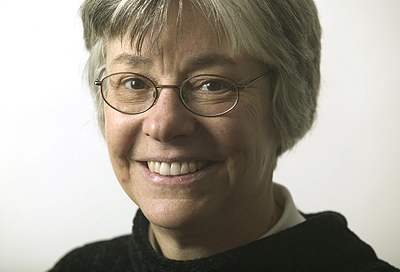Ask Me Another
During the Bates Fall Semester Abroad in Kanazawa, Japan, Sarah Strong’s students are experiencing the Japanese version of humanity’s confusion about nature. Japan’s paradoxical ethos is expressed on the one hand in “some of the most beautiful gardens that human beings have ever created,” Strong says — and on the other, in trash dumped at the foot of the revered Mount Fuji. Professor of Japanese Strong, who is co-leading the trip with Assistant Professor of Psychology Helen Boucher, spoke with staff writer Doug Hubley in August.
You’re teaching about nature and the environment. Helen is teaching cultural psychology. Have you harmonized your courses?
Bates is enthusiastic about the study of contemporary East Asia. For this program, there was enthusiasm for matching my course — which is not exclusively about traditional Japan, but includes that element — with one that’s wholly contemporary. My previous semester in Japan, in 2004, was weighted toward the traditional. We had a student rebellion: “No more temples!”

Sarah Strong led her third Fall Semester Abroad group to Japan this year.
How does your course mix the traditional and contemporary?
We look at traditional Japanese landscapes and gardens, and the concepts that form the tradition — the sense of nature, of mountains and streams, as a healing and helpful thing. Kanazawa has an old famous garden, Kenroku-en, that will be part of our classroom. Among other texts, we’ll look at a chapter of The Tale of Genji, written around the 11th century, that describes a great garden party. Aristocrats had these fabulous huge gardens that would have a lake, mountain, stream, bridge, and sandy white beach — both a recollection of the ocean shore and a performance place. They would float wine cups down the stream. Courtier poets would sit along the stream, and when a cup came to them they would pick it up, drink, write a poem, and put the cup back in the stream.
What’s the contemporary piece?
I want students to have a sense of the environmental disasters that mark the first half of the 20th century and the immediate postwar period. In the 1890s, the Ashio copper mine polluted the Watarase and Tone rivers. A Diet representative called Tanaka Shozo made a career out of protesting it, in vain for 10 years, and is credited with creating Japan’s first grassroots environmental movement.
We’ll also look at the Minamata mercury poisoning in the 1950s and ’60s. The people who suffered most were not in the city but in fishing villages around Minamata Bay. They ate mercury-tainted seafood. People suffered dramatically — people in the prime of the life who lost their mental capacity, their physical health. Some of their children couldn’t walk or talk. The writer Michiko Ishimure did the most to make Japanese people feel what was happening. She was a journalist and housewife who first encountered mercury patients in a hospital. She spoke the local dialect and just talked with them and spent her days with them. She captured their stories in a book titled Paradise in the Sea of Sorrow. Some people call it a kind of shamanistic recording, in how their spirits were inside her.
I want students to have a sense of the extensive, and some say overzealous, government earthworks projects, like landslide prevention in the mountains or hardening river beds for erosion and flood control. Everywhere along the ocean in Japan you see giant concrete jacks, the size of small buildings, protecting the shoreline.
And the forests at the foot of Mount Fuji are dumping grounds.
I want the students to be sophisticated enough to see that you can have this utterly, intensively fine aesthetic response to nature that has given us the most moving and appealing gardens in Kanazawa and Kyoto to which everyone in the world is drawn. And yet you can have this kind of random dumping at the foot of Mount Fuji.
Why is it important for Bates students to spend time in Japan?
Japan, with its rich, articulated social patterns, is one of the most challenging societies for a young American to take on. There are social expectations about every aspect of how we conduct ourselves. And after decades working in this field, I still feel there’s something extraordinary about the Japanese sense of beauty and nature. I think I can awaken my students’ response to these traditions. This is central to my enthusiasm for teaching.
How much language skill can a student pick up in a semester?
When we first get to Japan, they don’t go anywhere — they always ask, “Would you go with me?” By the end, when we go to Tokyo, they just shoot out everywhere, investigating. I used to think they needed me to explain the Tokyo subway system. They listened politely for five minutes, then told me they didn’t need any more instruction.